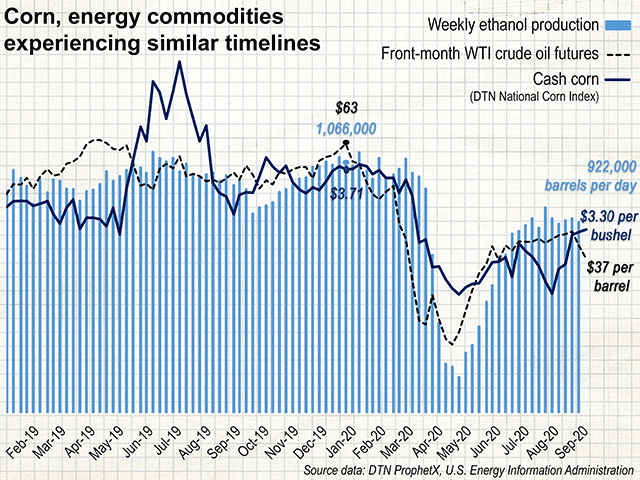Kub's Den
Summer Ends, Summer Road Trips Stop
For those who don't have kids in school, or calves to wean, or equipment to grease up before harvest, September could, in theory, be an excellent time for a road trip with beautiful fall foliage and mild weather and thin crowds anywhere you'd want to go.
However, in reality, we've experienced the first frost across a broad portion of the United States and now it feels like summer has ended. With it goes the traditional road trip season.
If the fuel market (i.e. the ethanol market) was watching for a recovery or boost in demand since the April doldrums, I'm afraid the market has seen all it's going to see. From here through the end of the year, the market already has a sense of how many consumers (automobile drivers) have been lost to work-from-home scenarios or the lack of entertainment destinations, and until something changes about the COVID-19 pandemic, demand appears to have plateaued.
Certain segments of the market are more susceptible to the demand bearishness than others. Top of the list are gasoline prices themselves, the most direct measure of the supply-and-demand balance for consumer fuel. Front-month RBOB futures went from $1.80 per gallon at the start of January, to a shocking $0.37 "COVID-low" in March, to a road-trip fueled recovery from June through August. However, demand is once again dropping week by week, and now gasoline futures prices at $1.10 remain 39% below their January starting point.
P[L1] D[0x0] M[300x250] OOP[F] ADUNIT[] T[]
Crude oil, of course, has gone on an even wilder ride -- from $63 per barrel at the end of 2019, to the infamous minus $40 temporary futures price in April, to $37 this week, which is 41% below the chart's starting point. Greater influence from speculators may be driving the relatively higher volatility in crude oil futures prices, but this market is also reflecting more than just domestic consumer fuel demand; it's also an indicator of global freight and industrial needs.
For the most part, though, crude oil prices are a pretty good benchmark of how much people are going places and doing things and making things and generally taking part in an economy.
Take note, therefore, that this benchmark has dipped suddenly this week, falling more than $2 per barrel on Tuesday alone. Traders' outlooks have been battered not only by dwindling demand, but also by unexpected August overproduction by some OPEC members. After successfully scaling back the global oversupply with agreed-upon production cuts through the summer, now monthly crude oil production from OPEC was actually 2% higher in August than it was in June.
The ethanol market itself is somewhat shielded from the vagaries of global energy supply and demand -- it is a smaller, more precisely calibrated market with specific uses and relatively flexible production. Correspondingly, its COVID dip, subsequent recovery, and eventual plateau have been less dramatic than that of crude oil. From a high of 1,095,000 barrels per day (bpd) produced in the U.S. during the week of Jan. 10, 2020, the most recent figure (922,000 bpd) is down "only" 16%.
Let's consider what a plateau here would mean: If we only produce 922,000 barrels of ethanol per day in the U.S., as the latest EIA figure from the just-ended marketing year showed, and if we pencil that out as a steady plateau through the full 2020-21 marketing year that's just beginning, that math would imply about 4.8 billion bushels (bb) of corn use for ethanol and byproducts in the national supply and demand tables. Those tables are due for an update this Friday, Sept. 11, and considering the latest USDA projection in August was still calling for 5.2 bb of corn to be used for ethanol in the 2020-21 marketing year, it appears there is still potential for further bearish cuts to this demand category (and a subsequently bearish adjustment to ending stocks), if we expect the current plateau to remain unchanged through the next 52 weeks of ethanol production data.
As an "energy" commodity, corn is even better insulated from the recent market volatility than ethanol. The loss of that chunk of business that would otherwise have gone to the ethanol plants has been noticeable, but the corn market has other participants (chiefly: livestock feeders both domestic and international) who've continued to be faithful purchasers.
The DTN National Corn Index, an average of cash bids collected daily from over 3,000 locations, ended 2019 at $3.71 per bushel, dropped to a low of $2.86 during the April nadir of COVID panic, and now around $3.30 is only 11% off its starting point.
Looking at this cash price index reflects the movement of both futures prices and basis bids during the slowdown and the recovery. Going forward, much will influence the corn market's local basis values (especially harvest pressure) and overall price level. But for any traders or corn sellers who were waiting for a recovery in energy demand, the flattening charts for weekly ethanol production and energy sector prices seem to be indicating we've already climbed to the top of this particular plateau.
Elaine Kub is the author of "Mastering the Grain Markets: How Profits Are Really Made" and can be reached at masteringthegrainmarkets@gmail.com or on Twitter @elainekub
(c) Copyright 2020 DTN, LLC. All rights reserved.




